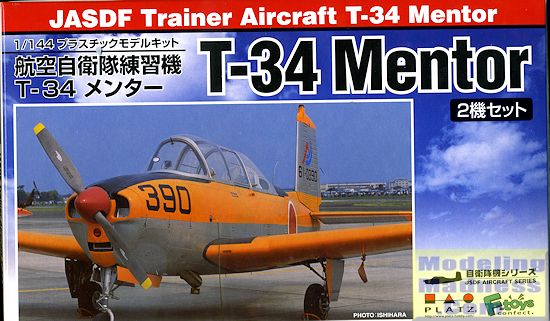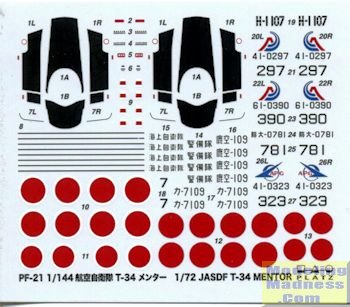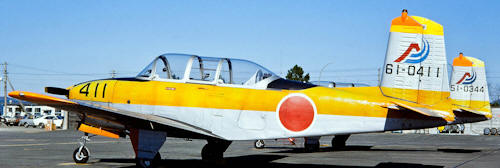
Platz 1/144 JASDF T-34 Mentor
| KIT #: | PF-21 |
| PRICE: | 2000 yen |
| DECALS: | Eight options |
| REVIEWER: | Scott Van Aken |
| NOTES: | New tool kit. Two complete kits |

| HISTORY |
The T-34 was the brainchild of Walter Beech, who developed it as the Beechcraft Model 45 private venture at a time when there was no defense budget for a new trainer model. Beech hoped to sell it as an economical alternative to the North American T-6/SNJ Texan, then in use by all services of the U.S. military.
Three initial design concepts were developed for the Model 45, including one with the Bonanza's signature V-tail, but the final design that emerged in 1948 incorporated conventional tail control surfaces for the benefit of the more conservative military (featuring a relatively large unswept vertical fin that would find its way onto the Travel Air twin-engine civil aircraft almost ten years later). The Bonanza's fuselage with four-passenger cabin was replaced with a narrower fuselage incorporating a two-seater tandem cockpit and bubble canopy, which provided greater visibility for the trainee pilot and flight instructor. Structurally, the Model 45 was much stronger than the Bonanza, being designed for +10g and -4.5g, while the Continental E-185 engine of 185 horsepower (hp) at takeoff (less than a third of the power of the T-6's engine) was the same as that fitted to contemporary Bonanzas.
Following the prototype were three Model A45T aircraft, the first two with the same engine as the prototype and the third with a Continental E-225, which would prove to be close to the production version. Production did not begin until 1953, when Beechcraft began delivering T-34As to the United States Air Force (USAF) and similar Model B45 aircraft for export. Production of the T-34B for the United States Navy (USN) began in 1955, this version featuring a number of changes reflecting the different requirements of the two services. The T-34B had only differential braking for steering control on the ground instead of nosewheel steering, additional wing dihedral and, to cater for the different heights of pilots, adjustable rudder pedals instead of the moveable seats of the T-34A. T-34A production was completed in 1956, with T-34Bs being built until October 1957 and licensed B45 versions built in Canada (125 manufactured by Canadian Car and Foundry), Japan (173 built by Fuji Heavy Industries), and Argentina (75 by FMA) until 1958. Beechcraft delivered the last Model B45s in 1959. Total production of the Continental-engined versions in the US and abroad was 1,904 aircraft.
| THE KIT |
 Next in their series of aircraft used by the JASDF is this very nice T-34 Mentor. Platz has provided the modeler with two kits along with enough markings options for eight aircraft. Since the T-34 is not exactly a large aircraft, even in 1/72 or 1/48, there are not a ton of parts with this one.
Next in their series of aircraft used by the JASDF is this very nice T-34 Mentor. Platz has provided the modeler with two kits along with enough markings options for eight aircraft. Since the T-34 is not exactly a large aircraft, even in 1/72 or 1/48, there are not a ton of parts with this one.
There is but a single sprue with the clear bits and stand being separate pieces. You are provided with a full interior that has seats molded in place and separate instrument panels. No control sticks or rudder pedals as frankly, you will not see all that much through the clear, but somewhat thick canopy section.
A one piece wing is provided with a slot already cut into it for the display stand. There are two fuselage halves along with a separate forward cowling piece to which you attach the prop. As with other Platz kits, this one can be displayed wheels up or down. For the wheels down option, there is a tail stand as there is no way you can fit enough weight into this one to prevent tail sitting. Even at this scale, the landing gear legs and wheels are separate pieces.
The instruction sheet is large and includes sections in English. There are five well drawn construction steps that show the various options. The other side of the sheet is devoted to markings and painting. There are eight options, all Japanese and while I have titled this preview 'JASDF' some of these may be  Navy. These are either in the early aluminum scheme or the later scheme that adds a lot of international orange. On both schemes, the tips of the flying surfaces are in da-glo. If the box plane is anything to go by, Japan's international orange is a paler shade than what we see on USN planes. To be honest, I think that this is actually da-glo as the paint will often fade to almost a yellow shade as you can see from the image below. In fact, I have a photo somewhere of a warbird where the owner thought it was supposed to be yellow and so painted his aircraft yellow and silver! Typical of Platz, the decal sheet is very comprehensive, offering even the
Navy. These are either in the early aluminum scheme or the later scheme that adds a lot of international orange. On both schemes, the tips of the flying surfaces are in da-glo. If the box plane is anything to go by, Japan's international orange is a paler shade than what we see on USN planes. To be honest, I think that this is actually da-glo as the paint will often fade to almost a yellow shade as you can see from the image below. In fact, I have a photo somewhere of a warbird where the owner thought it was supposed to be yellow and so painted his aircraft yellow and silver! Typical of Platz, the decal sheet is very comprehensive, offering even the  black anti-glare panels and the wing walk areas. They also include roundels for all eight options, even though you can only build two from the kit. Note that if you are modeling a later T-34, you'll need to scratch build the fin tip anti-collision light.
black anti-glare panels and the wing walk areas. They also include roundels for all eight options, even though you can only build two from the kit. Note that if you are modeling a later T-34, you'll need to scratch build the fin tip anti-collision light.
| CONCLUSIONS |
I am always quite pleased to see new kits from Platz. They pick very neat subjects and the resulting models always look just superb when finished. This one also has great potential for the aftermarket crowd or additional boxings.
| REFERENCES |
December 2014
Thanks to Platz for the preview kit. You can find this one at your favorite hobby shop or on-lineretailer.
If you would like your product reviewed fairly and fairly quickly, please contactthe editor or see other details in the